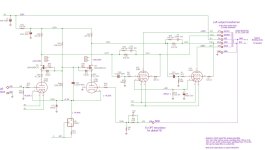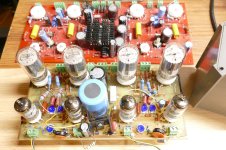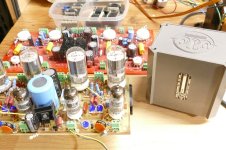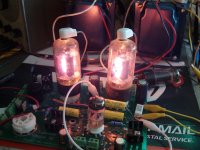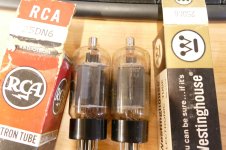It's a bit of a long story - you can read the whole thing on my website at http://www.pmillett.com/meamp2.html.
I designed an EL84 push-pull amp. It evolved from ETF.24, where a team including myself, John Bollinger, and (remotely) Douglas Piccard, and Jeremy Epstein designed and built an amp for a shootout at.
The basic circuit came from Douglas, using an ECC88 in cascode with N-channel MPSFETs as the front end. He and I had both done some designs using feedback from an ultralinear tap to the driver many years ago, and that was a starting point.
Here's the schematic, or download the whole thing as a PDF file: http://www.pmillett.com/file_downloads/meamp2_sch.pdf
The amp measures very well, around 0.02-0.03% distortion at 1W. The web page has full measurements.
I have to say that the ECC88 / MOSFET cascode diff amp is a simple but excellent front end for a push-pull amp.
Attachments
Hi Pete, I read the write-up on your site, but could not see the rationale for using the UL taps for feedback. What is the benefit? Or is it just that the experiment measured so well, that becomes the rationale?
Because it's there 🙂 and it worked well.Hi Pete, I read the write-up on your site, but could not see the rationale for using the UL taps for feedback. What is the benefit? Or is it just that the experiment measured so well, that becomes the rationale?
I think you could get the same effect by using resistor loads to both the plate and B+ to effectively get the same ratio. Though in the frequency domain using the UL taps is probably a bit different than using the entire winding due to winding capacitances, but that is just a guess.
The front end current is in opposition to the power tubes, so a bit of that effect is also in play.
Douglas
Douglas
Pete
Have you tried without global feedback, several of Douglas's E-Linear amplifiers (ST70 and 6CB5A designs) had no global feedback. Douglas's ST70 E-Linear sounded better with E-Linear feedback but without global feedback. Wondering if you had and was it better or worse (measurment and sonic). Douglas you can also give us some of your experiences.
Have you tried without global feedback, several of Douglas's E-Linear amplifiers (ST70 and 6CB5A designs) had no global feedback. Douglas's ST70 E-Linear sounded better with E-Linear feedback but without global feedback. Wondering if you had and was it better or worse (measurment and sonic). Douglas you can also give us some of your experiences.
In follow up correspondence to Walt Jung's "AudioXpress" articles on Current Sources, he was reminded that the LM317 is not a low noise device in this application. Probably not of serious consequence to this design.
A balance control in the 1st stage cathodes could improve the 2nd harmonic.
Increasing the 47 Ohm resistors or using a high value pot. across the CCS tail could improve the 3rd harmonic.
Increasing the 47 Ohm resistors or using a high value pot. across the CCS tail could improve the 3rd harmonic.
How would you incorporate a volume control into this amp? Would a 100K Log pot do the trick?
thanks for all the work you've done for the community.
w
thanks for all the work you've done for the community.
w
It works fine with no NFB. The gain is quite high, so it's best run with only load resistors to the UL tap. It would also be best to provide some balance adjustment as mentioned above.Have you tried without global feedback, several of Douglas's E-Linear amplifiers (ST70 and 6CB5A designs) had no global feedback. Douglas's ST70 E-Linear sounded better with E-Linear feedback but without global feedback. Wondering if you had and was it better or worse (measurment and sonic). Douglas you can also give us some of your experiences.
Of course, distortion and Zout are much higher, and LF response is worse, particularly the distortion at 20-50Hz. If I remember right between 0.1% and 0.2% at 1W. To me it sounds better with the NFB.
Yes, a normal volume pot in front would be fine. Depending on your source you might want to increase the gain a bit by lowering the global feedback.How would you incorporate a volume control into this amp? Would a 100K Log pot do the trick?
Yup. A cascode FET CCS would be better. But I don't think it makes much difference here, and I didn't want to require adjusting a CCS.In follow up correspondence to Walt Jung's "AudioXpress" articles on Current Sources, he was reminded that the LM317 is not a low noise device in this application. Probably not of serious consequence to this design.
Not your Mama amp :?) It downed on me that I still have of partial nickel pair of late Mike's LaFevre 8k PP UL (50%) OPTs and was contemplating either sale or a worthy the iron amp.since I can't afford the other " engineer's el84 amp " with the x 100 ticket price
Attachments
Pete
Have you tried without global feedback, several of Douglas's E-Linear amplifiers (ST70 and 6CB5A designs) had no global feedback. Douglas's ST70 E-Linear sounded better with E-Linear feedback but without global feedback. Wondering if you had and was it better or worse (measurment and sonic). Douglas you can also give us some of your experiences.
I have not added the gNFB to an E-Linear amp yet. For me, the entire exercise was to develop something that did 'better' without. On the 'better', I have done little in the way of measurement, and I'd love to go running off into that domain as I freely admit there are things I can not explain about why this works as well as it has for me.
Example: this amp runs what is effectively a pentode without screen grid current( the cascode ). I have usually used pentodes with varying amounts of screen grid current( wrt plate current ), and with a ccs in the tail...what is really happening? None? Lots? Medium?
Douglas
While digging through boxes to fill up my van with stuff I haven't used in years which will be sold or given away at the Dayton Hamfest in just over a week, I found some possible keepers. In a pile of transformers stashed under the workbench I found a pair of UTC LS-57's that haven't seen power in 12 to 15 years.
A pair of engineering degrees and a fancy job title at Motorola never made me a "real" engineer. I would rather guess, build, blow up, repeat, than calculate and simulate. There was far too much simulation and calculating in my department at work which was an advanced research group. I built the prototypes that got the next round of simulation and calculation funded.
I rarely ever spent much time with someone else's project or design as I can't seem to finish my own projects, but one popular Big Red Board kept me and lots of readers here occupied for a couple years. I cracked open a box full of old PC boards and found this. My first instinct was to hook it up, and crank it up, but I did that years ago. Maybe I could turn it down to a power level that works with the UTC transformers.........Turn it down? Not my style.
Maybe it's time to just grab a pile of parts, take a good guess, build it, then blow it up, and repeat. I would aim for about 20 WPC, but save the UTC's until after all the blow it up and repeat stuff is done. I have just the right tubes for the job too. Sleeping in the box with the red board, was my version of a shrunken Engineers amp. The two little tubes driving two bigger tubes scheme is about the only similarity. The output stage is UNSET. The driver is currently undecided. The output tubes are 6GF5's. It seems that I have a box full of them that I got when they were on the dollar list. They are a 6GE5 with the plate wings clipped and stuffed into a small bottle. Both evolved from the 6DQ6, a tube I learned on in the 1960's. A pair in UNSET will make 80 watts at the edge of red glow. They will live long and prosper at 20.
A pair of engineering degrees and a fancy job title at Motorola never made me a "real" engineer. I would rather guess, build, blow up, repeat, than calculate and simulate. There was far too much simulation and calculating in my department at work which was an advanced research group. I built the prototypes that got the next round of simulation and calculation funded.
I rarely ever spent much time with someone else's project or design as I can't seem to finish my own projects, but one popular Big Red Board kept me and lots of readers here occupied for a couple years. I cracked open a box full of old PC boards and found this. My first instinct was to hook it up, and crank it up, but I did that years ago. Maybe I could turn it down to a power level that works with the UTC transformers.........Turn it down? Not my style.
Maybe it's time to just grab a pile of parts, take a good guess, build it, then blow it up, and repeat. I would aim for about 20 WPC, but save the UTC's until after all the blow it up and repeat stuff is done. I have just the right tubes for the job too. Sleeping in the box with the red board, was my version of a shrunken Engineers amp. The two little tubes driving two bigger tubes scheme is about the only similarity. The output stage is UNSET. The driver is currently undecided. The output tubes are 6GF5's. It seems that I have a box full of them that I got when they were on the dollar list. They are a 6GE5 with the plate wings clipped and stuffed into a small bottle. Both evolved from the 6DQ6, a tube I learned on in the 1960's. A pair in UNSET will make 80 watts at the edge of red glow. They will live long and prosper at 20.
Attachments
I don't have a rational explanation for my results, but back when the Big Red Board thread was in full swing, I made some lists of every pin compatible driver tube that could be stuffed into the board without modifications. My current list has grown a bit since then. There are at least 45 different 7 pin tubes that can be used in that board. I believe that the original tube suggestion was the 6CB6. Within a few days the quest for more power eventually reached the point where I didn't have enough gain in the driver tube. That led to some serious tube rolling. The quest for gain led to the 6EW6. Then I started changing resistor values and measuring distortion. This led to the 6GU5, a hexode. The tube with 4 grids has a grid on either side of the screen, both of which are tied to the cathode. A 6GU5 tube with properly aligned grids will draw near zero screen current (well under 1 mA) and produce the lowest distortion. The 6GU5 has withstood the test of time and was Pete's driver choice in the 50 watt monoblock version.Example: this amp runs what is effectively a pentode without screen grid current( the cascode ). I have usually used pentodes with varying amounts of screen grid current( wrt plate current ), and with a ccs in the tail...what is really happening? None? Lots? Medium?
Douglas
After working outside all afternoon and chasing down some of the random thoughts that ran through my head, I may not use the 6GF5 for a 20 WPC amp as it is overkill. I may go for the venerable 6W6GT as it is pin compatible with all the usual audio tubes AND the father of the 6GF5, the 6DQ6. Attach a plate cap to pin 3 of the socket and you can use the 6BQ6, 6CU6, and 6DQ6 in the same socket as the typical audio tubes. NOTE that just plugging a TV sweep tube into a typical audio amp will almost guarantee some smoke, and probably a blown cathode bypass cap. Parts value changes are required. Been there, Blown that. Somewhere in my past, I literally found the melting point of a (skinny) 6BQ5GT. It is 120 Watts in push pull. The tube became gassy after several minutes at that level. The power started to drop and the THD started to climb. After a few more minutes one tube sucked air and the other flashed over. I didn't get pictures of that test, but I fried some rather ugly (fat) 6BQ6GA's that were sold as NOS. These put up a better fight.
Attachments
I should mention that the 6HB6 is NOT pin compatible with the 6BQ5/EL84.
But 6HB6 IS compatible with 6/10/16/29GK6, which is functionally the same as 6BQ5.
6HB6 and 29GK6 were both on the old $1 list.
But 6HB6 IS compatible with 6/10/16/29GK6, which is functionally the same as 6BQ5.
6HB6 and 29GK6 were both on the old $1 list.
Last edited:
The 6HA6/6HB6 was on the dollar menu at both Florida tube stores some time ago. I called Stan who told me that he had 20,000 of them and sent me 10. It took me a couple of weeks to hack up an SPP board and make them work..........quite a bit better than the usual 6BQ5/EL84. I called Stan to order a bunch, but "a single buyer bought all he had" a few days before I called. Somewhere in the same time frame all the 13GB5's disappeared. There were over 10K of them. I have not seen either tube used commercially, and I destroyed both of my test amps.6HB6 doesn't appear to have ever made it's way into an Amp
I grabbed a box full of 25DN6's from the tube seller that still has the "Quantity Special" list. 100 tubes would cost me $50 and 500 would cost me $175 but he did not have that many. I got 100 for $50 but he covered the shipping. The 6DN6/25DN6 is a very old tube number. About 10 of the tubes had tiny 15 watt plates inside. All the rest had a big fat plates capable of 100 watts per pair all day long.
I discovered a big sweep tube that could do 150 watts per pair without breaking a sweat, and properly built versions could hit 200 without redness. I visited his shop while I was In Orlando with a bunch of kids at Disney World during Christmas of 2019. He was not doing to well, his assistant had the week off, so I persuaded Stan to let me use his equipment to retrieve a box full of them from a top shelf in his warehouse. That was all I could bring back with me since my van had all of the essentials for 8 people in it. Stan was going to call me in mid January after he had found the rest of them. He died before that could happen.
Find odd voltage tubes cheap. Look on Amazon to see if an SMPS is available for that voltage, or a multiple of that voltage. Most of these are somewhat adjustable. IE, the 24 volt versions can be turned up to 26 volts.
Attachments
- Home
- Amplifiers
- Tubes / Valves
- EL84 "Engineer's Amp" (sort of)
